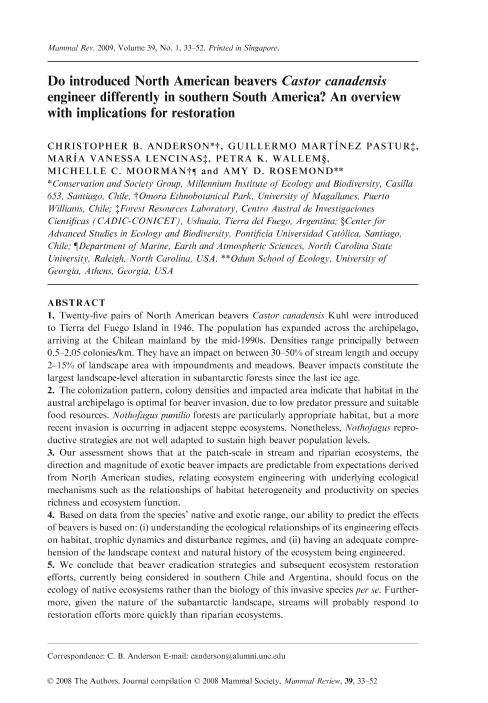Mostrar el registro sencillo del ítem
dc.contributor.author
Anderson, Christopher Brian

dc.contributor.author
Martínez Pastur, Guillermo José

dc.contributor.author
Lencinas, María Vanessa

dc.contributor.author
Wallem, Petra K.
dc.contributor.author
Moorman, Michelle C.
dc.contributor.author
Rosemond, Amy D.
dc.date.available
2021-06-16T13:29:23Z
dc.date.issued
2009-01
dc.identifier.citation
Anderson, Christopher Brian; Martínez Pastur, Guillermo José; Lencinas, María Vanessa; Wallem, Petra K.; Moorman, Michelle C.; et al.; Do introduced North American beavers Castor canadensis engineer differently in southern South America? An overview with implications for restoration; Wiley Blackwell Publishing, Inc; Mammal Review; 39; 1; 1-2009; 33-52
dc.identifier.issn
0305-1838
dc.identifier.uri
http://hdl.handle.net/11336/133992
dc.description.abstract
1. Twenty-five pairs of North American beavers Castor canadensis Kuhl were introduced to Tierra del Fuego Island in 1946. The population has expanded across the archipelago, arriving at the Chilean mainland by the mid-1990s. Densities range principally between 0.5-2.05 colonies/km. They have an impact on between 30-50% of stream length and occupy 2-15% of landscape area with impoundments and meadows. Beaver impacts constitute the largest landscape-level alteration in subantarctic forests since the last ice age. 2. The colonization pattern, colony densities and impacted area indicate that habitat in the austral archipelago is optimal for beaver invasion, due to low predator pressure and suitable food resources. Nothofagus pumilio forests are particularly appropriate habitat, but a more recent invasion is occurring in adjacent steppe ecosystems. Nonetheless, Nothofagus reproductive strategies are not well adapted to sustain high beaver population levels. 3. Our assessment shows that at the patch-scale in stream and riparian ecosystems, the direction and magnitude of exotic beaver impacts are predictable from expectations derived from North American studies, relating ecosystem engineering with underlying ecological mechanisms such as the relationships of habitat heterogeneity and productivity on species richness and ecosystem function. 4. Based on data from the species' native and exotic range, our ability to predict the effects of beavers is based on: (i) understanding the ecological relationships of its engineering effects on habitat, trophic dynamics and disturbance regimes, and (ii) having an adequate comprehension of the landscape context and natural history of the ecosystem being engineered. 5. We conclude that beaver eradication strategies and subsequent ecosystem restoration efforts, currently being considered in southern Chile and Argentina, should focus on the ecology of native ecosystems rather than the biology of this invasive species per se. Furthermore, given the nature of the subantarctic landscape, streams will probably respond to restoration efforts more quickly than riparian ecosystems.
dc.format
application/pdf
dc.language.iso
eng
dc.publisher
Wiley Blackwell Publishing, Inc

dc.rights
info:eu-repo/semantics/openAccess
dc.rights.uri
https://creativecommons.org/licenses/by-nc-sa/2.5/ar/
dc.subject
CASTOR CANADENSIS
dc.subject
ECOSYSTEM ENGINEER
dc.subject
EXOTIC
dc.subject
INVASION
dc.subject
NOTHOFAGUS
dc.subject
PATAGONIA
dc.subject.classification
Conservación de la Biodiversidad

dc.subject.classification
Ciencias Biológicas

dc.subject.classification
CIENCIAS NATURALES Y EXACTAS

dc.subject.classification
Otras Ciencias Agrícolas

dc.subject.classification
Otras Ciencias Agrícolas

dc.subject.classification
CIENCIAS AGRÍCOLAS

dc.subject.classification
Ecología

dc.subject.classification
Ciencias Biológicas

dc.subject.classification
CIENCIAS NATURALES Y EXACTAS

dc.title
Do introduced North American beavers Castor canadensis engineer differently in southern South America? An overview with implications for restoration
dc.type
info:eu-repo/semantics/article
dc.type
info:ar-repo/semantics/artículo
dc.type
info:eu-repo/semantics/publishedVersion
dc.date.updated
2021-03-26T13:05:01Z
dc.journal.volume
39
dc.journal.number
1
dc.journal.pagination
33-52
dc.journal.pais
Reino Unido

dc.journal.ciudad
Londres
dc.description.fil
Fil: Anderson, Christopher Brian. Instituto de Ecología y Biodiversidad; Chile. Consejo Nacional de Investigaciones Científicas y Técnicas. Centro Austral de Investigaciones Científicas; Argentina
dc.description.fil
Fil: Martínez Pastur, Guillermo José. Consejo Nacional de Investigaciones Científicas y Técnicas. Centro Austral de Investigaciones Científicas; Argentina
dc.description.fil
Fil: Lencinas, María Vanessa. Consejo Nacional de Investigaciones Científicas y Técnicas. Centro Austral de Investigaciones Científicas; Argentina
dc.description.fil
Fil: Wallem, Petra K.. Pontificia Universidad Católica de Chile; Chile
dc.description.fil
Fil: Moorman, Michelle C.. Universidad de Magallanes; Chile
dc.description.fil
Fil: Rosemond, Amy D.. North Carolina State University; Estados Unidos
dc.journal.title
Mammal Review

dc.relation.alternativeid
info:eu-repo/semantics/altIdentifier/url/https://onlinelibrary.wiley.com/doi/10.1111/j.1365-2907.2008.00136.x
dc.relation.alternativeid
info:eu-repo/semantics/altIdentifier/doi/https://doi.org/10.1111/j.1365-2907.2008.00136.x
Archivos asociados
